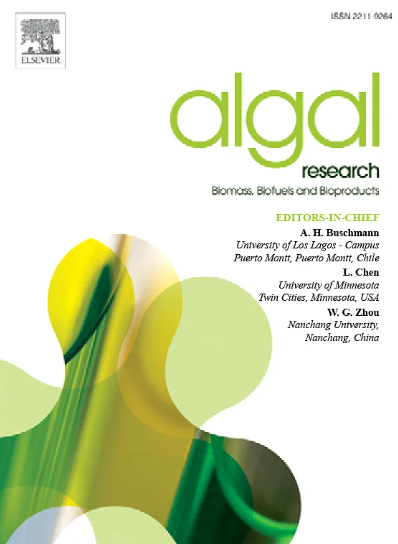从微藻和大藻中提取的天然指甲油色素
IF 4.6
2区 生物学
Q1 BIOTECHNOLOGY & APPLIED MICROBIOLOGY
Algal Research-Biomass Biofuels and Bioproducts
Pub Date : 2025-02-28
DOI:10.1016/j.algal.2025.103983
引用次数: 0
摘要
对环境可持续性和与合成色素相关的健康风险的日益关注,推动了对天然替代品的需求激增,尤其是在化妆品行业。本研究探讨了在指甲油配方中使用微藻和巨藻色素的可行性,重点研究了它们的色素谱、稳定性和实用可能性。研究了小球藻、螺旋藻、云云藻和Caulerpa等植物色素的潜在来源。提取过程采用溶剂法,利用紫外可见光谱、ATR-FTIR和1H NMR技术对其成分进行表征,包括叶绿素和类胡萝卜素。提取的色素呈现出不同的颜色:小球藻产生黄绿色,螺旋藻产生深绿色,褐藻产生棕绿色,Caulerpa产生浅绿色。其中,小球藻和螺旋藻的叶绿素a含量分别为51.92±15.16 μg/mL和134.46±21.68 μg/mL,褐藻的叶绿素a含量最高,为148.23±16.56 μg/mL。叶绿素a浓度最低的是蕨草,为14.72±4.77 μg/mL。分析表明,叶绿素a是所有物种的主要色素,而类胡萝卜素有助于颜色的多样性。稳定性测试表明,在45°C条件下,含有褐藻色素的薄膜在21天内保持了90%以上的原始颜色,优于含有小球藻和Caulerpa sp的薄膜,后者表现出明显的降解。这些发现证明了藻类衍生色素作为化妆品中合成色素的可持续、长期和无毒替代品的潜力。然而,在色素稳定性和提取工艺可扩展性方面仍然存在挑战,这两者都需要配方策略来提高商业应用的长期性能。本文章由计算机程序翻译,如有差异,请以英文原文为准。

Natural pigments from micro- and macro-algae for nail polish application
Growing concerns about environmental sustainability and the health risks associated with synthetic pigments have fueled a surge in demand for natural alternatives, particularly in the cosmetics industry. This study explores the feasibility of using pigments derived from both microalgae and macroalgae in nail polish formulations, focusing on their pigment profiles, stability, and practical possibilities. Pigments from Chlorella sp., Spirulina sp., Undaria sp., and Caulerpa sp. were investigated as potential sources. The extraction process employed solvent-based methods, with characterization carried out using UV–visible spectroscopy, ATR-FTIR, and 1H NMR techniques to identify their compositions, including chlorophylls and carotenoids. The extracted pigments exhibited a diverse palette of colors: Chlorella sp. produced a yellowish-green, Spirulina sp. produced dark green, Undaria sp. produced a brownish-green, and Caulerpa sp. produced a light green-yellow. Chlorella sp. and Spirulina sp. exhibited chlorophyll a concentrations of 51.92 ± 15.16 μg/mL and 134.46 ± 21.68 μg/mL, respectively, while Undaria sp. demonstrated the highest concentrations of chlorophyll a (148.23 ± 16.56 μg/mL). However, Caulerpa sp. revealed the lowest chlorophyll a concentration of 14.72 ± 4.77 μg/mL. The analysis revealed that chlorophyll a was the predominant pigment across all species, while carotenoids contributed to the diversity of hues. Stability tests showed films incorporating pigments from Undaria sp. retained over 90 % of their original color over 21 days at 45 °C, outperforming those with Chlorella sp. and Caulerpa sp., which displayed noticeable degradation. These findings demonstrate the potential of algae-derived pigments as sustainable, long-term, and non-toxic alternatives to synthetic pigments in cosmetic applications. However, challenges remain in terms of pigment stability and extraction process scalability, both of which require formulation strategies to improve long-term performance in commercial applications.
求助全文
通过发布文献求助,成功后即可免费获取论文全文。
去求助
来源期刊

Algal Research-Biomass Biofuels and Bioproducts
BIOTECHNOLOGY & APPLIED MICROBIOLOGY-
CiteScore
9.40
自引率
7.80%
发文量
332
期刊介绍:
Algal Research is an international phycology journal covering all areas of emerging technologies in algae biology, biomass production, cultivation, harvesting, extraction, bioproducts, biorefinery, engineering, and econometrics. Algae is defined to include cyanobacteria, microalgae, and protists and symbionts of interest in biotechnology. The journal publishes original research and reviews for the following scope: algal biology, including but not exclusive to: phylogeny, biodiversity, molecular traits, metabolic regulation, and genetic engineering, algal cultivation, e.g. phototrophic systems, heterotrophic systems, and mixotrophic systems, algal harvesting and extraction systems, biotechnology to convert algal biomass and components into biofuels and bioproducts, e.g., nutraceuticals, pharmaceuticals, animal feed, plastics, etc. algal products and their economic assessment
 求助内容:
求助内容: 应助结果提醒方式:
应助结果提醒方式:


